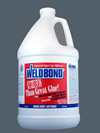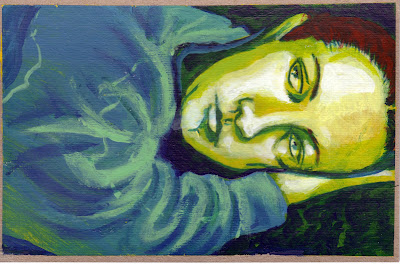Oh crap who did I delete?
Mike Valcourt?
Anyone else, I didn't mean to. Sorry.
Thursday, 3 December 2009
Thursday, 22 October 2009
Friday, 16 October 2009
Canoe Seat, Nopiming Park: WIP
 I now have a French box easel permanently cached at my sister-in-law's cabin in Nopiming Provincial Park near the Ontario border. It seems to be one of the places where I can be totally alone to do whatever I want (within reason). It's also one of the first places I painted when picked up a brush for the first time last year. Last week I knocked off a quick sketch of a canvas canoe seat that hangs in the boat house down by the lake front -- despite a cold breeze blowing off the lake and the snow slowing my fingers. I'll keep painting everytime I'm out there unless a mysterious canoe accident comes my way.
I now have a French box easel permanently cached at my sister-in-law's cabin in Nopiming Provincial Park near the Ontario border. It seems to be one of the places where I can be totally alone to do whatever I want (within reason). It's also one of the first places I painted when picked up a brush for the first time last year. Last week I knocked off a quick sketch of a canvas canoe seat that hangs in the boat house down by the lake front -- despite a cold breeze blowing off the lake and the snow slowing my fingers. I'll keep painting everytime I'm out there unless a mysterious canoe accident comes my way.Colours: Cadmium Red (med.), Sap Green, Naples Yellow, Indian Red, Titanium White, Payne's Grey. Turp wash to sketch in mixing my colour lines with Liquin Impasto.
8x10" Oil on canvas board.
8x10" Oil on canvas board.
Sunday, 11 October 2009
Thursday, 25 June 2009
Sunday, 21 June 2009
Wednesday, 20 May 2009
Thursday, 7 May 2009
PVA Sizing/Ground Recipe for Oil or Acrylic

Why make your own sizing? Three reasons. It's fun. It's ready when you are. It's cheap. (I know, I know, it sounds like the perfect date.)
Equipment and Supplies
- 5 to 10 lb. bag of calcium carbonate (a.k.a. whiting). Should cost about $5-10. Whiting is available in bulk at pottery supply stores like the "Sounding Stone" in Winnipeg.
- 1 gallon (4 l.) jug of PVA white (not yellow) carpenters' glue like Weldbond or Lepages. (~$25)
- Electric drill with paint mixer propeller or an electric hand mixer with two beaters or even a kitchen whisk (hint: don't use these for food prep afterward).
- Two-10 oz. empty Campbell's Soup cans. One for wets (water, glue pigment) one for dry (whiting).
- A 1 gallon or slightly larger pail with resealable lid (I use an clean, empty dishwasher-detergent pail from SuperValue).
Instructions
Using the empty soup cans mix the following into the pail:
- 3 Parts PVA Glue to
- 3 (to 6) Parts Water to
- 9 (to 12) Parts "Whiting" and
- 1 (to 2) Parts Titanium White pigment (optional as the chalk will makes it white also) I use Rheotech it's good and it's cheap.
Start by mixing the water and glue together with your drill-mixer. Put in the whiting three cans at a time mixing constantly until you reach 9 cans. Mix for a while and then let the mixture slake (rest) in the pot for 5 or 10 minutes. Mix again to make sure all the lumps have broken up and add the titanium white. Keep mixing. Let it slake once or twice more. Test the mixture on an old board or canvas. This is a "stock" solution but if it's too thick (read: too gluey) try adding more water. Too watery? Try adding more whiting. Different glues may have different results. When applying to board I would thin your "stock" solution with about half water (or more) for the first two coats.
Build up the layers from thinnest to thickest sanding lightly between coats. Three to five coats should be about right. PVA dries quickly between coats but should be left for at least 24 hours to cure properly before applying gesso or painting.
When you're brushing on the latter "thick" coats -- if you find the brush marks annoy you try using a clean damp to wet trim brush to "brush out" or "knock down" the marks with a perpendicular stroke.
Makes about a gallon of sizing per batch. A gallon of glue will make three or four batches though.
Tuesday, 28 April 2009
Artists Can Claim $1000 At Tax Time
If you:
Here is the full link.
- composed a dramatic, musical, or literary work;
- performed as an actor, dancer, singer, or musician in a dramatic or musical work;
- performed an artistic activity as a member of a professional artists' association that the Minister of Canadian Heritage has certified; or
- created a painting, print, etching, drawing, sculpture, or similar work of art. For income tax purposes, it is not an artistic activity when you reproduce these items.
Here is the full link.
Sunday, 19 April 2009
Using Polyester As A Support For Oil Painting
This was my first attempt at using polyester fabric as a support for oil painting. It's comparable in price to either good linen or heavy canvas (~$14/metre/96" Roll). Basically, I'm looking for newer better materials which leave me more time for painting and less time for preparing the supports -- which I'm making myself. The age old problem of painting on either linen or canvas with oil is that the oil itself will eventually attack and destroy the support's fibres if it isn't sealed with something to protect it. Although the notion of rabbit skin glue and gesso is romantic with two kids to chase after I don't have the time to fuss with it. Acrylic dispersion gessos are the next best alternative but I've been researching changing the support itself to something that's not affected by the drying oils. Enter polyester. I'm still applying a layer or two of thinned acrylic gesso (to protect it from UV) with a light sanding between and after coats. Stretching is where things become interesting. The big advantage I'm seeing is that the polyester doesn't shrink or expand with humidity. It's very stable compared to natural fibres. I have a pair of canvas/upholsters' stretching pliers which I bought from Utrecht which help me pull the material to the final tautness. Once it's stapled that's it. It stays put, tight as a drum or what you will. I love this stuff. The only drawbacks I've encountered are that I have to cut my dimensions with scissors because it's so strong it doesn't rip on the warp or weft lines like canvas. The other is just stretching carefully to avoid "puckers" on my deep extruded strainers.
Tuesday, 24 March 2009
Sunday, 15 March 2009
Fiddling With Colours
 A colour mixing chart from Golden (my favourite acrylics).
A colour mixing chart from Golden (my favourite acrylics).Nice in that it shows the ratios of how to mix some of the old standards (read: I was looking for cerulean blue recipe tonight because I'd run out...)
~m
http://www.goldenpaints.com/images/ColorMixingGuide.pdf
Monday, 9 March 2009
Monday, 2 March 2009
Sunday, 18 January 2009
Tuesday, 6 January 2009
Saturday, 3 January 2009
Subscribe to:
Posts (Atom)













